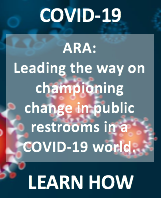Restroom Security
There are several areas of concern when it comes to proper Restroom Security and Accessibility. See also Reducing Crime in Rest Areas from the National Highway Traffic Safety Administration.

Entries and Exits to Public Restrooms
To improve security particularly for women, entrances to toilet facilities should be located where a clear site-line exist to high traffic public area’s.
A labyrinth entrances directly along major traffic corridors provide both the ‘sense of’ and actual security. Worse-case configuration have restrooms at the end of long corridor’s where users have no acoustic or visual site-line to a high person traffic area
Customer Locked Restrooms
Everyone understands the reasons for locks on stalls. Locks on the outside door to the full restroom, however, significantly impact the availability of the facility. An unlocked facility may find a person in a stall while another is washing, and a third is using a hand dryer. This same situation in a locked room would have 2 people waiting outside. Locked rooms also increase misuse, such as longer employee smoke breaks, that further increase the likelihood of queuing.
Stall Doors
There should be no outside latches that could be used to lock a person in a stall.
Restroom Doors
Labyrinth entrances (door-less) avoid the problem of an outward swinging door hitting someone. With no door opening to give warning of possible visit by security personnel labyrinth design is less conducive to unwanted activity. Additionally, the sound signature of criminal activity is more likely to be detected when no doors exist.
Ceilings
Open ceilings or a ceiling with ventilation provide a conduit for sound. Some sound dampening is necessary to assure privacy but the knowledge that a call for help can be heard reduces apprehension of both the occupant and a waiting parent or opposite sex care-provider.
Door Handles
Where paper towels are present many will use a piece of towel to grip the handle. Some littering of the restroom floors can reduced by recognizing this smart practice and providing trash receptacles close to the exit.
Door and Mirrors Sight Lines
Thoughtlessly placed mirrors may provide a sight-line into areas where privacy was intended, for example the unshielded urinals in the men’s room. In some case poorly placed toilet fixtures can be viewed directly. Thoughtfully placed mirrors can increase security, especially in Women’s Restrooms, by allowing a line of sight from the entrance to the back of the restroom.
The worse situation is an external restroom door with internal slide locks. They provide no mechanism for building management to intervene when an occupant fails to respond after an excessive period of usage.
Portable Sanitation Units often have outside latches that accommodate a pad lock. A child with a small stick can easily ‘imprison’ an occupant.
Privacy Partitions
Urinal privacy sufficiently high to prevent adjacent urinal person to person eye-contact is an impediment to nefarious activities.
Most toilet stalls partitions do not reach the floor to accommodate easy mopping. This configuration is also an impediment to misuse such as long employee smoke breaks. Long tongue latches that catch inside door frame allow stall doors to stay closed even if poorly installed frames become misaligned.
Toilet Paper Issues
- Misuse versus availability
- Roll-over (switch-over to second roll) when empty
- High dissolvability tissue prevents clogs in high use environments
- Restricted quantity push button feed systems
Public Policy
Prohibit loitering and panhandling near public restrooms.
Other Voices
Around the corner, the public toilets have blue lights. This is a pragmatic Swiss solution for preventing needle junkies from using that space for shooting up: Under the blue lights, they can’t see their veins.
Dallas Morning News, Inc 8/5/09
Contact Us
American Restroom Association, Inc.
P.O. Box 21237
Catonsville, MD 21228

MEDIA: Let us connect you with the best expert to support your news and media projects.
INVENTORS, MANUFACTURERS, SUPPLIERS, & SERVICE PROVIDERS: We want to hear your stories about how you are leading change in restroom design and maintenance!


